Although it was Girlfriend's first visit to Kyushu, the island has a special place in my heart as it was the site of my first Japan experience: Six weeks in Nagasaki Prefecture during the summer of 1999. Now, for the first time in eight years, it was time for me to revisit that charming locale. Below are some of the best photos we took on our trip, carefully selected from a collection of more than 400.

First order of business after our arrival in Nagasaki was to eat lunch, which we did at a restaurant in the Dejima district. Lunch turned out to be toruko rice (Turkish rice), which is one of the city's signature dishes. It's rice, topped with gravy and a fried pork cutlet (which is also topped with gravy). It's almost always served with spaghetti, which somehow makes it seem significantly less Turkish. It's almost like a recipe designed by committee. Like all things in Nagasaki, one is forced to assume that the city's history of amiable international relations somehow contributed to its dominating atmosphere of cultural confusion. Hence, Turkish rice.
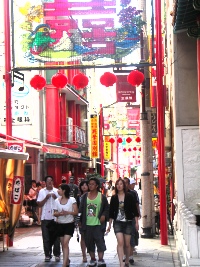 Turkish rice, as it turns out, is heavy-duty food. We walked it off by visiting the recently built replica of Dejima trading post, and then it was on to nearby Chinatown. Nagasaki's colorful Chinatown is a compact four city blocks of shops that deal mainly in Bruce Lee dolls that don't really look like Bruce Lee. I was glad to visit the area again, mainly because I found my single greatest souvenir of the whole trip there: A t-shirt with a simple rendition of a Hotarujaya streetcar sign printed on the back. (Another of the city's claims to fame is its endearing streetcar system, just one more in a list of things that tie present-day Nagasaki to its long-gone counterpart.) The mere sound of the name Hotarujaya -- meaning "Firefly Tea House" -- has a strong, nostalgic ring to it for me as well as for many Japanese.
Turkish rice, as it turns out, is heavy-duty food. We walked it off by visiting the recently built replica of Dejima trading post, and then it was on to nearby Chinatown. Nagasaki's colorful Chinatown is a compact four city blocks of shops that deal mainly in Bruce Lee dolls that don't really look like Bruce Lee. I was glad to visit the area again, mainly because I found my single greatest souvenir of the whole trip there: A t-shirt with a simple rendition of a Hotarujaya streetcar sign printed on the back. (Another of the city's claims to fame is its endearing streetcar system, just one more in a list of things that tie present-day Nagasaki to its long-gone counterpart.) The mere sound of the name Hotarujaya -- meaning "Firefly Tea House" -- has a strong, nostalgic ring to it for me as well as for many Japanese.
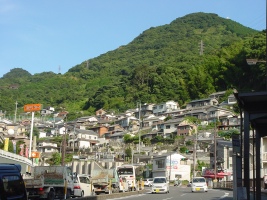 The aforementioned nostalgia must have had a very profound effect on me, because the next thing we did was jump on the streetcar and ride to Hotarujaya. It's the last stop on the easternmost branch of the tram system, and is located right in front of the Radiation Effects Research Foundation, workplace of Ms. Tani, host of my 1999 homestay. By this time the oppressive heat of the afternoon was taking its toll, so Girlfriend and I ducked into Royal Host to eat the first of what would be many servings of shaved ice. By the end of our trip, I think we were averaging about 1.35 shaved ices a day.
The aforementioned nostalgia must have had a very profound effect on me, because the next thing we did was jump on the streetcar and ride to Hotarujaya. It's the last stop on the easternmost branch of the tram system, and is located right in front of the Radiation Effects Research Foundation, workplace of Ms. Tani, host of my 1999 homestay. By this time the oppressive heat of the afternoon was taking its toll, so Girlfriend and I ducked into Royal Host to eat the first of what would be many servings of shaved ice. By the end of our trip, I think we were averaging about 1.35 shaved ices a day.
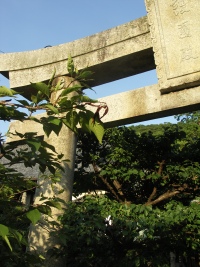 Next on the agenda, perhaps my most anticipated part of the whole trip: Teramachi. Stretching southwesterly from Hotarujaya along the foot of Mt. Kazagashira, Teramachi (literally, "Temple Town") is a quiet road lined with Buddhist temples on one side and stonecutters' shops on the other. Altogether there are about twelve temples before you reach the south end of Teramachi, near the Hamanomachi shopping arcade. Since my homestay house was located a couple hundred meters up the mountain from Teramachi, I walked down this tranquil street many times on the way down to the commercial district during my first visit to Nagasaki. Seeing it again was a great experience, although by this time, I had been walking all day and my legs felt like they were going to self-destruct.
Next on the agenda, perhaps my most anticipated part of the whole trip: Teramachi. Stretching southwesterly from Hotarujaya along the foot of Mt. Kazagashira, Teramachi (literally, "Temple Town") is a quiet road lined with Buddhist temples on one side and stonecutters' shops on the other. Altogether there are about twelve temples before you reach the south end of Teramachi, near the Hamanomachi shopping arcade. Since my homestay house was located a couple hundred meters up the mountain from Teramachi, I walked down this tranquil street many times on the way down to the commercial district during my first visit to Nagasaki. Seeing it again was a great experience, although by this time, I had been walking all day and my legs felt like they were going to self-destruct.

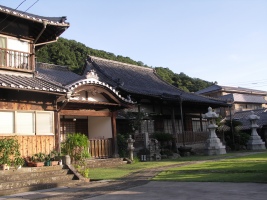
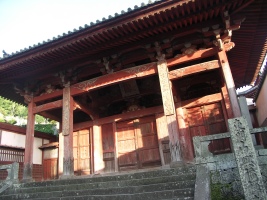
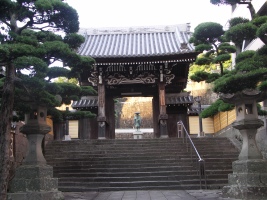
DAY TWO
 Day Two of our travels fell on August 9, the 62nd anniversary of the atomic bomb attack on Nagasaki in 1945. It seemed obvious, therefore, that we should use that day to visit Urakami, the neighborhood where the bomb exploded. First stop: Sannojinja, a Shinto shrine near the bomb's hypocenter. In front of the shrine there are two mighty trees that were gutted by the nuclear explosion, but are kept alive and standing even today by cores of plastic running up their trunks. As you can see from the picture (below, left), both trees are huge and the damage done to them by the bomb was extensive. Girlfriend is shown for scale. And also for cuteness.
Day Two of our travels fell on August 9, the 62nd anniversary of the atomic bomb attack on Nagasaki in 1945. It seemed obvious, therefore, that we should use that day to visit Urakami, the neighborhood where the bomb exploded. First stop: Sannojinja, a Shinto shrine near the bomb's hypocenter. In front of the shrine there are two mighty trees that were gutted by the nuclear explosion, but are kept alive and standing even today by cores of plastic running up their trunks. As you can see from the picture (below, left), both trees are huge and the damage done to them by the bomb was extensive. Girlfriend is shown for scale. And also for cuteness.

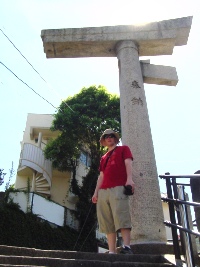
The other main feature of Sannojinja is the Ipponbashiratorii (above, right). It's the remainder of a stone arch (called torii), more than half of which was slapped down by the force of the atomic blast.
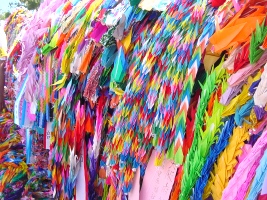 Next was Peace Park, which was packed with thousands of people attending the Peace Ceremony. Because of the crowds, we couldn't get close enough to the park's famous statue to get any really good pictures of it, although later in the day we were able to sneak behind it and snap a rare shot of its back, something I bet most visitors to Nagasaki never even think of. What we were able to photograph, however, were thousands of origami cranes chained together like Hawaiian leis. After being turned away from the main square because it was full, we decided to leg it to the Hypocenter Monument.
Next was Peace Park, which was packed with thousands of people attending the Peace Ceremony. Because of the crowds, we couldn't get close enough to the park's famous statue to get any really good pictures of it, although later in the day we were able to sneak behind it and snap a rare shot of its back, something I bet most visitors to Nagasaki never even think of. What we were able to photograph, however, were thousands of origami cranes chained together like Hawaiian leis. After being turned away from the main square because it was full, we decided to leg it to the Hypocenter Monument.
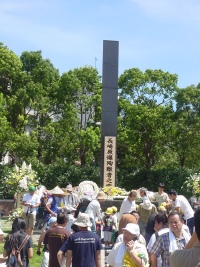 The black monolith in this photo marks the point on the earth, 470 meters above which the bomb exploded at 11:02 AM on August 9, 1945. We arrived at the monument around 10:45, just in time for the commemorative moment of silence. It would be the second time in my life to be in Nagasaki on this anniversary.
The black monolith in this photo marks the point on the earth, 470 meters above which the bomb exploded at 11:02 AM on August 9, 1945. We arrived at the monument around 10:45, just in time for the commemorative moment of silence. It would be the second time in my life to be in Nagasaki on this anniversary.
Unfortunately, around 11:00, an old Japanese woman who I think was a Christian missionary started talking to Girlfriend and me about her English studies. The incomprehensible description she gave of the American who taught her English was probably the worst possible publicity that teacher could ever receive. She was babbling on and on, completely oblivious to the time, so when the moment of silence started at 11:02 I had to clear my throat and point to all the people with their heads bowed to get the woman to shut up. Girlfriend and I were both annoyed by the woman's lack of tact, and it occurred to me that a Christian missionary talking endlessly while everyone around her prayed was not without irony.
 After vising the Atomic Bomb Museum and Urakami Cathedral, we headed back to central Nagasaki to have lunch. JR Nagasaki Station now has a shopping center adjacent to it which was wasn't there the first time I visited. Therein we found food. And after lunch, I feel it is necessary to state, we partook of the biggest shaved ice of the entire vacation.
After vising the Atomic Bomb Museum and Urakami Cathedral, we headed back to central Nagasaki to have lunch. JR Nagasaki Station now has a shopping center adjacent to it which was wasn't there the first time I visited. Therein we found food. And after lunch, I feel it is necessary to state, we partook of the biggest shaved ice of the entire vacation.
Known as shirokuma ("polar bear"), this massive conglomerate of shaved ice, fruit and ice cream is a survival staple in Kyushu's oppressive summertime heat. The thing was about the size of a child's head. Girlfriend and I double-teamed the polar bear and destroyed it completely.
 Alas, it was time again to tear ourselves away from the air conditioning and continue our sightseeing. We took a short walk to the Twenty-Six Saints Monument, which marks a hill where a bunch of Japanese and foreign Christians were executed in the late sixteenth century (for practicing Christianity, which was forbidden in Japan at the time). I don't know what the temperature was at this point, but our arrival at 26 Saints was, in my memory, the hottest point of our trip. Girlfriend and I could barely move, but we had to push on. After witnessing a stray cat climbing a tree to catch a cicada (which the cat then carried away, chirping angrily in the cat's mouth), we decided to make a quick trip back to the hotel to change clothes and psych ourselves up for more and more walking.
Alas, it was time again to tear ourselves away from the air conditioning and continue our sightseeing. We took a short walk to the Twenty-Six Saints Monument, which marks a hill where a bunch of Japanese and foreign Christians were executed in the late sixteenth century (for practicing Christianity, which was forbidden in Japan at the time). I don't know what the temperature was at this point, but our arrival at 26 Saints was, in my memory, the hottest point of our trip. Girlfriend and I could barely move, but we had to push on. After witnessing a stray cat climbing a tree to catch a cicada (which the cat then carried away, chirping angrily in the cat's mouth), we decided to make a quick trip back to the hotel to change clothes and psych ourselves up for more and more walking.
 A little later, after a change of clothes and brief recharge at the hotel, we found ourselves in the vicinity of Orandazaka (Dutch Slope), which is famous for its old, western-style buildings. Neither Girlfriend nor I was enthusiastic about the uphill slog entailed therein, but being the essential sightseeing point that Orandazaka is, it seemed necessary in some way. Besides, Orandazaka formed part of the walking route from our hotel to Glover's Garden, another essential stop.
A little later, after a change of clothes and brief recharge at the hotel, we found ourselves in the vicinity of Orandazaka (Dutch Slope), which is famous for its old, western-style buildings. Neither Girlfriend nor I was enthusiastic about the uphill slog entailed therein, but being the essential sightseeing point that Orandazaka is, it seemed necessary in some way. Besides, Orandazaka formed part of the walking route from our hotel to Glover's Garden, another essential stop.
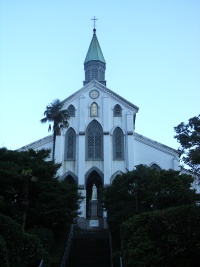 On the way up the hill to Glover's Garden is Oura Tenshudo, one of Nagasaki's best-known cathedrals. Something I thought was funny about every Catholic church we saw in Nagasaki: They all have the word "cathedral" written in Japanese on the facade (barely visible in this photo). Usually a cross on the steeple does the job of denoting a church, but in Nagasaki they I guess they like to spell things out.
On the way up the hill to Glover's Garden is Oura Tenshudo, one of Nagasaki's best-known cathedrals. Something I thought was funny about every Catholic church we saw in Nagasaki: They all have the word "cathedral" written in Japanese on the facade (barely visible in this photo). Usually a cross on the steeple does the job of denoting a church, but in Nagasaki they I guess they like to spell things out.
We also saw the cutest cat in the whole world hanging around the gate to a temple adjacent to Oura Cathedral. The cat didn't seem to like us all that much, but it sat still long enough for us to take its picture. Girlfriend described it as "a supermodel among cats." But don't take my word for it:
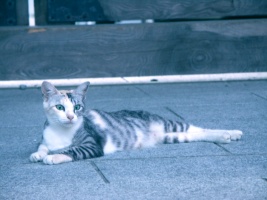
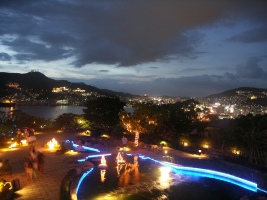 The final destination of the evening was Glover's Garden, site of the home of 19th century Scottish businessman (and co-founder of what is now Kirin Brewery) Thomas Glover. From its hilltop location, the garden commands a beautiful view of the harbor with Inasa-yama visible in the west. Visitors can walk inside the estate's various buildings, which are set up in museum-like still lifes of what the rooms probably looked like in the days of their use. None of these buildings, however, is air-conditioned, and even after sundown it was too hot to be hanging around inside.
The final destination of the evening was Glover's Garden, site of the home of 19th century Scottish businessman (and co-founder of what is now Kirin Brewery) Thomas Glover. From its hilltop location, the garden commands a beautiful view of the harbor with Inasa-yama visible in the west. Visitors can walk inside the estate's various buildings, which are set up in museum-like still lifes of what the rooms probably looked like in the days of their use. None of these buildings, however, is air-conditioned, and even after sundown it was too hot to be hanging around inside.
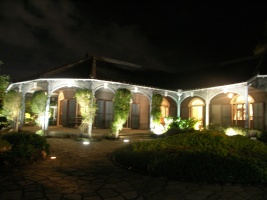

On our third day in Nagasaki, we began by walking to Koshibyo, a Confucian shrine in the Oura district. The shrine grounds are a high-density hotbed of lions, dragons and red and gold architecture. I challenge you to find a more Chinese-looking place, even in China.
White stone statues of Confucian disciples are lined up in rows outside the shrine's main structure. I didn't count them, but I later learned that there are 72 of these statues populating the shrine grounds. The one in the photo below waved at Girlfriend and she waved back.
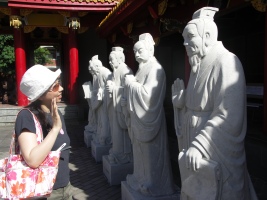
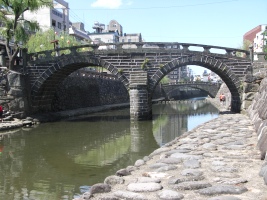 Next: Meganebashi. It's silly, but if you go to Nagasaki there's this unwritten law that you must take a picture of Meganebashi (meaning "Spectacles Bridge," since the bridge and its reflection in the Nakashima River resemble the circular glasses that Thomas Dolby is wearing on the cover of his 1982 album The Golden Age of Wireless). There are stone bridges built in this style in many locations in Japan, so I'm not sure why the one in Nagasaki is so famous.
Next: Meganebashi. It's silly, but if you go to Nagasaki there's this unwritten law that you must take a picture of Meganebashi (meaning "Spectacles Bridge," since the bridge and its reflection in the Nakashima River resemble the circular glasses that Thomas Dolby is wearing on the cover of his 1982 album The Golden Age of Wireless). There are stone bridges built in this style in many locations in Japan, so I'm not sure why the one in Nagasaki is so famous.
All right, enough about Meganebashi. I'm sure you're on the edge of your seat waiting to find out where we went next! Aren't you? Wait for it....wait for iiiiiit.....
 SUWA JINJA!
SUWA JINJA!
Well, actually, first we went to a sort of boring museum, then ate lunch, and then we went to Suwa Jinja. Good thing we ate lunch beforehand, because visiting this massive shrine entails a whole hell of a lot of stair climbing. If my sister had been with us, she'd have done a "Rocky run" up to the top. Or maybe she wouldn't have, because it was like a hundred degrees Fahrenheit. I seem to remember spending a lot of money on water from vending machines on this particular day.
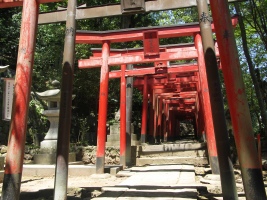 Around the back of Suwa Shrine, we found a nice hidden area with a pond full of turtles and a torii-lined path. The path was also buzzing with weird, orange and green flying insects I'd never seen before, but I refused to let these mutants ruin my Suwa experience. The path led to a a stone prification fountain carved with the kanji meaning "heart wash." There, my heart underwent its first cleaning in a long, long time. I had a little laugh to myself when I imagined finding a similar fountain carved with the kanji for "Lung Brush," but I never came upon such a fountain, sadly.
Around the back of Suwa Shrine, we found a nice hidden area with a pond full of turtles and a torii-lined path. The path was also buzzing with weird, orange and green flying insects I'd never seen before, but I refused to let these mutants ruin my Suwa experience. The path led to a a stone prification fountain carved with the kanji meaning "heart wash." There, my heart underwent its first cleaning in a long, long time. I had a little laugh to myself when I imagined finding a similar fountain carved with the kanji for "Lung Brush," but I never came upon such a fountain, sadly.
 The final item on our final day in Nagasaki City was a reunion with Ms. Tani. She drove us up Mt. Kazagashira (across the harbor from Mt. Inasa), where we took a moment to snap this photo with Sakamoto Ryoma, anti-Tokugawa idealist and key catalyst for the Meiji Restoration. Both in statue form and in photographs, Ryoma carries a Napoleonic air of non-stop badass. This must be because of the cross-armed posture and the skeptical expression he always has. Carrying a sword doesn't hurt, either. (Well, it can potentially hurt if you're clumsy, but I digress.) We had plans to go out to eat with Ms. Tani and her friend Sayumi (accoring to Ms. Tani, Sayumi can be considered my "host aunt"...but Sayumi, always the fountain of humor, insists on the younger-sounding "host sister"), but we still had some time to kill before dinnertime...so what do you suppose we did?
The final item on our final day in Nagasaki City was a reunion with Ms. Tani. She drove us up Mt. Kazagashira (across the harbor from Mt. Inasa), where we took a moment to snap this photo with Sakamoto Ryoma, anti-Tokugawa idealist and key catalyst for the Meiji Restoration. Both in statue form and in photographs, Ryoma carries a Napoleonic air of non-stop badass. This must be because of the cross-armed posture and the skeptical expression he always has. Carrying a sword doesn't hurt, either. (Well, it can potentially hurt if you're clumsy, but I digress.) We had plans to go out to eat with Ms. Tani and her friend Sayumi (accoring to Ms. Tani, Sayumi can be considered my "host aunt"...but Sayumi, always the fountain of humor, insists on the younger-sounding "host sister"), but we still had some time to kill before dinnertime...so what do you suppose we did?
 Why, we flew a kite, of course.
Why, we flew a kite, of course.
Near the top of Mt. Kazagashira there is a kite shop. The owner, who cannot be described as anything but a "kite master," gave us a twenty-minute lecture on the history of kites in Nagasaki (another fingerprint of Dutch influence on the city, it turns out) and then took us outside to try our hands at flying a kite. It was only my second time to fly a kite, and my first time to fly a kite properly. We stood at the peak of Mt. Kazagashira with the kite in the air, the sun on our faces and dragonflies buzzing all around us, and boy, did it feel like summer. Sayumi is shown here taking a turn at keeping the thing in the air. The Dutch flag kite we flew is shown in the inset. The guy in the purple happi is the Kite Master, in case you couldn't guess.
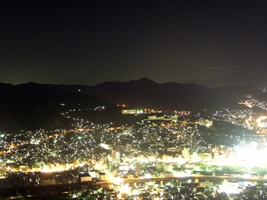 After flying the kite and then eating some really high-quality seafood, we drove up Mt. Inasa to take in more of Nagasaki's famous night view. Most of my photos didn't turn out because I couldn't remember how to set the camera for low-light shots without a tripod, but I did get away with one or two nice ones. For the most part, however, the night view from Mt. Inasa is perhaps best left to one's memory. Photos of it, as is often the case, never turn out exactly faithful to the actal sight. I usually shrug off tourism "purists" who avoid travel photography for this reason, but they might be onto something in cases like this.
After flying the kite and then eating some really high-quality seafood, we drove up Mt. Inasa to take in more of Nagasaki's famous night view. Most of my photos didn't turn out because I couldn't remember how to set the camera for low-light shots without a tripod, but I did get away with one or two nice ones. For the most part, however, the night view from Mt. Inasa is perhaps best left to one's memory. Photos of it, as is often the case, never turn out exactly faithful to the actal sight. I usually shrug off tourism "purists" who avoid travel photography for this reason, but they might be onto something in cases like this.
Only one photo is necessary to summarize the latter half of our vacation (which we spent on Fukue Island, part of the Goto Archipelago):
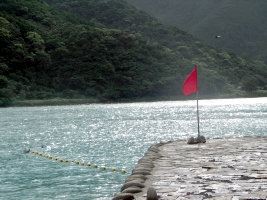
The entire time we were there, the red flag was flying on the beach, denoting that it was unsafe to swim because of high winds. The only chance we had to enter the water was during the high tide, when a nearby inlet would fill with shallow water. But that water disappeared completely by about 11:00 AM every morning.
I didn't take photos of the most memorable things about the island: The air conditioner that cost 200 yen per hour to use, the ubiquitous wharf roaches scurrying everywhere and the six-inch centipede that turned up in our room. All the same, I believe that the favorable review of the beach we had read beforehand was probably accurate, and the experience could have been immensely better if we hadn't had such back luck with the weather.
This concludes my photographic recap of our summer vacation. It has taken way too long to format so many photos, upload them and then think of interesting things to say about them, so I am done talking about Nagasaki. We now return to Chorus, Isolate, Confirm, already in progress.
